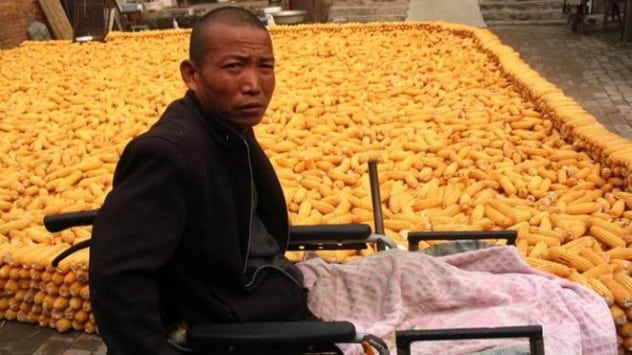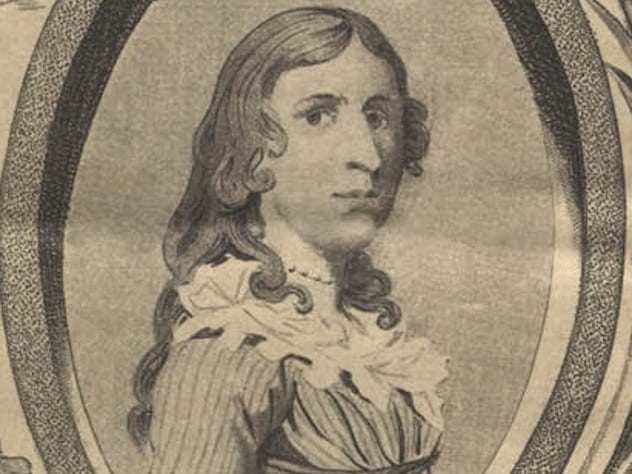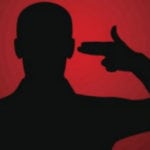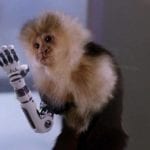 Politics
Politics  Politics
Politics  Weird Stuff
Weird Stuff Ten Bizarre Facts About The Doge Meme
 Our World
Our World 10 Ways Your Christmas Tree Is More Lit Than You Think
 Movies and TV
Movies and TV The 10 Coolest Stars to Set Sail on The Love Boat
 History
History 10 Things You Didn’t Know About the American National Anthem
 Technology
Technology Top 10 Everyday Tech Buzzwords That Hide a Darker Past
 Humans
Humans 10 Everyday Human Behaviors That Are Actually Survival Instincts
 Animals
Animals 10 Animals That Humiliated and Harmed Historical Leaders
 History
History 10 Most Influential Protests in Modern History
 Creepy
Creepy 10 More Representations of Death from Myth, Legend, and Folktale
 Politics
Politics 10 Political Scandals That Sent Crowds Into the Streets
 Weird Stuff
Weird Stuff Ten Bizarre Facts About The Doge Meme
 Our World
Our World 10 Ways Your Christmas Tree Is More Lit Than You Think
Who's Behind Listverse?

Jamie Frater
Head Editor
Jamie founded Listverse due to an insatiable desire to share fascinating, obscure, and bizarre facts. He has been a guest speaker on numerous national radio and television stations and is a five time published author.
More About Us Movies and TV
Movies and TV The 10 Coolest Stars to Set Sail on The Love Boat
 History
History 10 Things You Didn’t Know About the American National Anthem
 Technology
Technology Top 10 Everyday Tech Buzzwords That Hide a Darker Past
 Humans
Humans 10 Everyday Human Behaviors That Are Actually Survival Instincts
 Animals
Animals 10 Animals That Humiliated and Harmed Historical Leaders
 History
History 10 Most Influential Protests in Modern History
 Creepy
Creepy 10 More Representations of Death from Myth, Legend, and Folktale
10 People Who Performed Surgeries On Themselves And Survived
The thought of undergoing surgery is a nightmare to many. Even the fear is unparalleled. Of course, there’s the fear of death, of dying on the table, not to mention the fear of pain (even with the use of anesthesia) and other worries.
However, there are some who have put these fears aside and operated on themselves. Ironically, in one incident, the fear of pain is the self-surgeon’s reason for doing so. To be clear, anesthesia is rarely used in self-surgeries, since the person performing the procedure needs to be conscious to see what he is doing.
10 Jan De Doot
Open Cystolithotomy

In 1651, Dutch blacksmith Jan de Doot performed open cystolithotomy on himself to remove a painful bladder stone. De Doot had undergone two similar surgeries earlier. Both were done by stonecutters and were extremely painful. He was not prepared to undergo such pain again, so he just left the stone alone.
The stone did not leave de Doot alone and continued to cause him unbearable pain, making a visit to the stonecutter unavoidable. However, de Doot was so determined not to do so again that he decided to remove the stone himself.
Before the surgery, he sent his wife to the market and called his brother over. Jan’s brother helped him hold his scrotum while he made an incision to reach his bladder. The hole was not big enough, and de Doot needed to do squats to make it bigger. Thereafter, he removed the stone with two fingers before sending his brother to call a healer to sew the incision.
The bladder stone was big. It was the size of a hen’s egg and was something de Doot was rather proud of.[1] He kept it as a souvenir and is even said to have painted it gold. In 1655, he even had Carel van Savoyen paint a portrait of him holding the stone and knife he used for the surgery. The painting is currently on display at the Laboratory of Pathology in the University of Leiden.
9 Ines Ramirez Perez
Caesarean Section

Ines Ramirez Perez was alone with her children in her home in Oaxaca, Mexico, one night in March 2000 when she started feeling pains in her belly. The pain was familiar. It was the same one she felt when her water broke during an earlier pregnancy. However, she lost that baby because she did not reach the hospital in time for a caesarean section.[2]
Ines was determined to save her baby this time. She sent one of her children to buy a kitchen knife with a 15-centimeter (6 in) blade. Before starting, she had three small glasses of liquor. With the knife, she tore an 18-centimeter (7 in) hole in her abdomen, shifted her organs—which even spilled outside—and brought out her baby, all without anesthesia.
Once done, Ines cut the umbilical cord, returned her organs back into her body, and told her son to get a man to stitch her abdomen. The man arrived and attempted sewing the wound with a needle and thread but later took her to a clinic one hour away. At the clinic, Ines was referred to a hospital two hours away. She returned home five days later with her baby.
8 Aron Ralston
Amputation

In 2003, Aron Ralston was rappelling down a slot canyon in Southeastern Utah when he slipped, causing a boulder to dislodge and trap his right arm against the side of the canyon. Ralston tried freeing his arm but was unsuccessful. He tried chip away at the boulder with the knife blade from his multi-tool, but that didn’t work, either.
He knew rescue was not coming anytime soon, since he had been hiking alone and did not tell anyone where he was going. The trapped half of his right arm soon became numb and even started decomposing. At one point, he pierced his dead thumb with his knife and heard the hiss of escaping air.
After being trapped for five and a half days, knowing he would die in the canyon if he did not take any action, Ralston performed a crude surgery on himself. He used his body weight to break the bones of the arm against the boulder before using the multi-tool to cut the tendons, flesh, and tissue around the almost amputated arm. Once free, he took a picture of the severed forearm trapped in the boulder and left the canyon. A family later found him and called emergency services. Ralston’s experience was made into the film 127 Hours.[3]
7 Zheng Yanliang
Amputation

In April 2012, Chinese farmer Zheng Yanliang amputated his right leg with a saw. The leg was diseased, blackened, inflicted with gangrene, and already expelling maggots. Before resorting to self-amputation, Zheng had visited a hospital concerning his infected legs. He was told he needed surgery, which cost 300,000 yuan for one leg and over one million yuan for both.
Zheng did not have such money. All he had was 20,000 yuan, which was not even enough for one leg. He quietly returned home. Within three months, his right leg had reached the state described above. The leg got so bad that Zheng could see its bones.
Unable to bear the pain any longer, he grabbed a saw and a knife and started sawing off the leg. Twenty minutes later, the limb was off. Those 20 minutes could well have been the longest of his life, since amputated his leg without anesthesia. It was very painful, and he bit on a stick covered with a towel all through. Zheng’s story later filtered to the Chinese media, and concerned citizens donated money to him to amputate the left leg.[4]
6 Amanda Feilding
Trepanation

Trepanation involves the surgical removal of bones from the skull. It was first done about 10,000 years ago, making it one of the oldest surgical procedures performed by man. However, it was usually for a different reason.
In the past, people underwent trepanation to treat skull injuries, cure insanity and headaches, and allow evil spirits leave their bodies. Today, trepanation is used to treat internal bleeding in the skull. However, there are some who believe trepanation is necessary to improve the quality of the brain. Amanda Feilding is one such person.
In the early 1980s, she approached several surgeons for the procedure before resorting to self-surgery. Some turned her down, and some agreed, only to reverse their decision over fears of the consequences should things go south. So Amanda decided to do it herself. She took some anesthesia and used a dentist’s drill to bore a hole in her skull. A few hours later, she left home for a party with a scarf wrapped around her head, despite losing a liter of blood.
Amanda said she felt better after the procedure. She continued to advocate for trepanation and didn’t hesitate to promote it at every opportunity she gets. When she ran for parliament in 1983, her campaign slogan was “Vote Feilding—Trepanation for the National Health.”[5]
5 Leonid Rogozov
Appendectomy

In 1961, 27-year-old Soviet doctor Leonid Rogozov diagnosed himself with acute appendicitis. However, there was a problem. He was on a Soviet research station in Antarctica, and the continent was already in winter, which is usually exceptionally harsh. This meant there was no way he could get outside help or evacuation to a hospital.
Leonid could not get any tangible medical help from his colleagues, either, since he was the only doctor in the station. So he chose the only option left: self-surgery. On the day of the surgery, he instructed his colleagues on what to do while he operated on himself. He was so specific that he even instructed them on what to do if he passed out.
Leonid could not use general anesthesia on himself since he needed to be conscious. He only used local anesthesia on his abdominal wall and started feeling pains the moment he started working on his insides. He bled during the two-hour-long surgery and almost lost consciousness. However, he completed it successfully. Two weeks later, he was back to work.
The surgery was positive propaganda for the Soviet Union. The fact that Yuri Gagarin became the first man in space 18 days earlier greatly multiplied its effect. Leonid got the Order of the Red Banner of Labor for his effort.[6]
4 Deborah Sampson

Deborah Sampson was one of the first female soldiers in the US military. During the Revolutionary War, at a time when women were forbidden from enlisting in the army, she dressed as a man, took on the alias of Robert Shirtliff, and enlisted in the Continental Army.
Sampson worked as a scout, spying on the British Army. She sometimes found herself in combat and was injured several times. One of the injuries was caused by a musket ball that lodged in her leg. It required surgery, but Sampson, fearing that her real identity would be discovered, performed the procedure on herself. The surgery was successful but not professional and would cause permanent injuries.
Sampson’s identity was not saved, either; it was discovered after she fell ill during the war. The army discharged her without honor. The US government also refused to give her any pension for decades after the war, since she was listed as an “invalid soldier.” After decades of touring the US and telling her story, she started receiving her pension in 1816.[7]
3 Roland Mery
Sex Reassignment Surgery

In 2009, 61-year-old Roland Mery from the UK needed a sex reassignment surgery so bad that he did it himself. Before resorting to self-surgery, he had visited a hospital, where he was told he needed to wait for two years. That was too long for him, so one morning, he took some painkillers and went into his bathroom. Using makeshift surgical tools, he removed his genitals.
Once done, he yelled to his wife, “Ring 999 Julie, I’ve done it!” An ambulance showed up and transported Roland to Royal Gwent Hospital, where the doctor on duty told him he did a good job. However, his wife could not follow him to the hospital since officers believed she had attacked her husband. They treated her as a suspect and even had forensic experts sweeping her home for evidence of the supposed crime.[8]
2 Viktor Yazykov
Abscess Drainage

In 1998, Russian sailor and army veteran Viktor Yazykov was competing in the nine-month-long Around Alone sailing contest, which involved competitors sailing around the world alone, when he injured himself in the elbow while in the South Atlantic. With his computer, he exchanged e-mails with the competition’s doctor, Dr. Daniel Carlin, who was in far-away Boston. Viktor’s injury soon developed an abscess that could have been deadly had it burst underneath his skin.[9]
Dr. Carlin told Viktor he needed to drain the abscess himself. Viktor received the e-mail detailing the procedure in the evening. Not long after, his solar-powered computer went flat after the Sun went down.
Viktor decided to proceed with the surgery that evening, as his arm was getting worse. He cut his elbow with a scalpel to drain the abscess. However, this also caused bleeding—heavy bleeding that continued for two hours. Nevertheless, Viktor continued with the procedure. By the time he was through, the cabin floor was covered in blood, and his hand was cold, white, and felt like rubber. He passed out after he took some red wine, chocolate, and aspirin.
Viktor contacted Dr. Carlin the next morning to receive further instructions. He completed the first leg of the race and stopped over in South Africa for two weeks before continuing with the second leg. He was sure to get a power system that did not rely on the Sun before continuing.
1 Dr. Evan O’Neill Kane
Appendectomy

Dr. Evan O’Neill Kane performed an appendectomy on himself on February 15, 1921. He hadn’t planned on operating on himself. In fact, he was in surgery, awaiting the surgeon who was to operate on him, when he decided to do it himself. Being the chief surgeon of the hospital, he told the staff to stand back as he sat himself up with pillows, injected himself with anesthetic, and started cutting into himself with the aid of mirrors. Thirty minutes later, he had removed the problematic appendix.
The surgery was a success. The only time the staff watching the procedure panicked was when Dr. Kane leaned too far forward, pushing his intestines outside his body. However, Dr. Kane was unfazed. He just pushed the intestines back and continued the operation.
Dr. Kane stated that he performed the surgery on himself to better understand anesthesia and how patients felt during surgeries. Eleven years later, he attempted another surgery on himself. This time, it was a hernia. However, it wasn’t so successful, and he contracted pneumonia, which killed him three months later.[10]
Read more amazing surgical stories on 10 Unimaginable & Horrific Botched Surgeries and 10 Fascinating Reattachment Surgeries.








